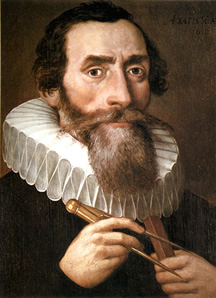People / Johannes Kepler
About
Johannes Kepler, 1610
Johannes Kepler
What do we know about Johannes Kepler today? He discovered the laws of planetary motion, known today as Kepler’s Laws. With his introduction into the use of logarithms he contributed to the spread of this new style of computation in Germany, he made optics the subject of scientific inquiry and supplied proofs for the discoveries of his contempoary Galileo Galilei.
These achievements have established Kepler primarily as one of the pioneers of modern science in our eyes. We must bear in mind however that his thought was also deeply shaped by religious belief. Kepler, in the words of Wikipedia, “also incorporated religious arguments and reasoning into his work, motivated by the religious conviction that God had created the world according to an intelligible plan that is accessible through the natural light of reason”. In this sense Kepler himself did not call the distillations of his most famous discoveries “laws” but considered his insights to be mere expressions of the fundamental harmony that God had imparted to his creation..
What, then, are Kepler’s three laws of planetary motion? 1. The orbit of every planet is an ellipse with the sun at a focus. 2. A line joing a planet and the sun sweeps out equal areas during equal intervals of time. 3. The square of the orbital period of a planet is directly proportional to the cube of the semi-major axis of its orbit.
Kepler was born on 27 Dezember, 1571 at Weil der Stadt geboren. He was a precocious and brilliant child, impressing travellers at his grandfather’s inn with his mathematical faculty. He also took an interest in astronomy early on; the Great Comet of 1577 and the lunar eclipse of 1580 left lasting impressions on him. From 1584 Kepler attended the monastic school at Adelberg, from 1586 the school at Maulbronn, another former monastery. Despite his impoverished family background he began to study theology in 1589 at the University of Tübingen. One of his teachers there was the great mathematician and astronomer Michael Mästlin, who acquainted Kepler with Nicolaus Copernicus’ heliocentric system of planetary motions.
At the age of 23 Kepler accepted a call as a mathematics teacher from the Protestant school in Graz, where he developed a cosmological theory in defence of Copernicus. He published it in 1597 under the title “Mysterium Cosmographicum”.
In the 1590s Kepler started his regular correspondence with Galileo Galilei and, above all, Tycho Brahe. The close contact he developed to Rudolph I’s court astronomer Tycho led to Kepler being appointed to the post of imperial mathematician two days after Tycho’s death in Prague in 1601. In addition to being in charge of casting horoscopes for the Emperor and of compiling the famous Rudolphine Tables, Kepler also worked on the first astronomical model of the heavens that did not rely on orbits. Containing the first and the second of Kepler’s Laws, it was completed in 1606 and published under the title “Astronomia nova” in 1609.
After Rudolph’s death in 1612 Kepler, himself recently widowed, moved his family to Linz, where he took up a post as a teacher and district mathematician. In 1613 he married Susanne Reuttinger, the daughter of an Eferding patrician family. Three of their six children survived into adult life. When religious tensions came to a head in Linz in 1626 – Kepler’s library was temporarily impounded by agents of the Catholic Counter-Reformation, his children were being forced to attend Catholic mass, the city of Linz was besieged – the Keplers moved again, this time to Ulm.
In 1627 Kepler found a new patron in Albrecht von Wallenstein, who valued Kepler above all as someone who was able to provide exact astronomical data to his court astrologers. Kepler spent much of his time towards the end of his life travelling. He died in Regensburg in 1630 at the age of 58.




